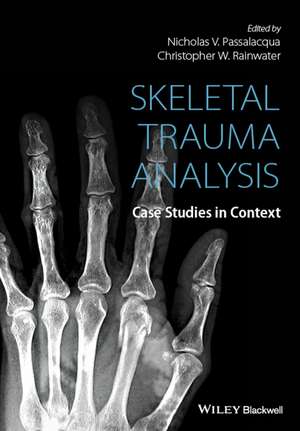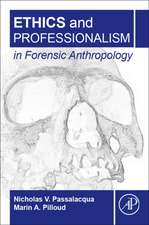Skeletal Trauma Analysis – Case Studies in Context
Autor NV Passalacquaen Limba Engleză Hardback – 28 mai 2015
Preț: 893.20 lei
Preț vechi: 940.21 lei
-5% Nou
170.94€ • 177.80$ • 141.12£
Carte tipărită la comandă
Livrare economică 12-26 aprilie
Specificații
ISBN-10: 1118384229
Pagini: 304
Dimensiuni: 178 x 253 x 22 mm
Greutate: 0.62 kg
Editura: Wiley
Locul publicării:Chichester, United Kingdom
Public țintă
Primary Market:This book will be necessary for any practicing forensic anthropologist and/or forensic pathologist dealing with human skeletal trauma
Secondary Market:
This book will also be key for use as a text in graduate level classroom training and research in bony trauma
Descriere
In the post–Daubert era, forensic science disciplines are increasingly informed by robust, statistically–sound experimental research. The educational value of the well–documented case study, however, remains as important as ever. Emphasizing known contextual information, this volume serves as a case–driven guide to skeletal trauma analysis through the unique perspective of each chapter’s authors. Both forensic anthropologists and pathologists contribute skeletal trauma cases covering a range of topics including child abuse, blunt force trauma, descents from height, plane crashes, sharp force trauma and dismemberment, gunshot wounds, blast trauma, and burned body interpretation. Several chapters also include a discussion of potentially confounding taphonomic influences such as animal scavenging, water immersion, burning, and extended postmortem intervals. Detailed descriptions with multiple supporting images allow the practitioner’s skeletal trauma interpretation to be compared to the “answer” as it pertains to the known circumstances surrounding the traumatic events of each case.
Textul de pe ultima copertă
In the post–Daubert era, forensic science disciplines are increasingly informed by robust, statistically–sound experimental research. The educational value of the well–documented case study, however, remains as important as ever. Emphasizing known contextual information, this volume serves as a case–driven guide to skeletal trauma analysis through the unique perspective of each chapter’s authors. Both forensic anthropologists and pathologists contribute skeletal trauma cases covering a range of topics including child abuse, blunt force trauma, descents from height, plane crashes, sharp force trauma and dismemberment, gunshot wounds, blast trauma, and burned body interpretation. Several chapters also include a discussion of potentially confounding taphonomic influences such as animal scavenging, water immersion, burning, and extended postmortem intervals. Detailed descriptions with multiple supporting images allow the practitioner’s skeletal trauma interpretation to be compared to the “answer” as it pertains to the known circumstances surrounding the traumatic events of each case.
Cuprins
List of contributors xi
1 Introduction 1
Nicholas V. Passalacqua and Christopher W. Rainwater
Skeletal trauma analysis: case studies in context 2
References 6
2 Atypical gunshot and blunt force injuries: wounds along the biomechanical continuum 7
Brian F. Spatola
Introduction 7
Background 8
Gunshot trauma 10
Blunt force trauma 11
Biomechanical continuum 12
Case 1: depressed fracture of inner table from historic gunshot contusion 14
Case 2: depressed fracture from .32 caliber, short, Smith & Wesson projectile 15
Case 3: penetrating depressed fracture from detached umbrella tip 17
Case 4: depressed fracture from perforating blunt impact from edged metal foreign object 19
Discussion 19
Conclusion 23
Acknowledgments 24
Disclaimer 24
References 24
3 Over–interpretation of bone injuries and implications for cause and manner of death 27
João Pinheiro, Eugénia Cunha, and Steven Symes
Introduction 27
The cases 29
Scene context 33
Autopsy and police investigation 35
Discussion and conclusions 38
Acknowledgments 40
References 40
4 Skeletal injuries in cases of child abuse: two case studies from the Harris County Institute of Forensic Sciences 42
Jason M. Wiersema and Jennifer C. Love
Introduction 42
Case 1 43
Case 2 50
Conclusions 55
References 55
5 Blunt force trauma patterns in the human skull and thorax: a case study from northern California 56
Eric J. Bartelink
Introduction 56
Case background 58
Biological profile 58
Antemortem trauma 59
Perimortem trauma 61
Trauma interpretation 66
Case resolution 68
Conclusions 69
Acknowledgments 70
References 70
6 Patterns of skeletal trauma inflicted during the Spanish Civil War 74
Nicholas V. Passalacqua, Ciarán Brewster, Marina Martínez de Pinillos González, and José Miguel Carretero Díaz
Introduction 74
The Spanish Civil War 74
Materials 76
Examples of trauma from Monte Costaján 77
Patterns of skeletal trauma 85
Conclusions 88
References 89
7 Shot and beaten to death? Suspected projectile and blunt force trauma in a case involving an extended period of postmortem water immersion 90
Hugo F.V. Cardoso, Katerina S. Puentes, and Luís F.N. Coelho
Introduction 90
Case description 92
Trauma analysis 94
Discussion and conclusions 102
Acknowledgments 106
References 106
8 Man’s best friend: a case study of ballistics trauma and animal scavenging 108
Gina Hart
Introduction 108
Bone biomechanics 108
Case study 110
References 116
9 Skeletal evidence of violent sexual assault in remains with excessive evidence of scavenging 118
Hugh E. Berryman and Tiffany B. Saul
Introduction 118
Case history 118
Analysis 119
An additional finding 124
Discussion 126
Conclusions 128
References 129
10 Neurocranial fractures 130
Jennifer C. Love
Introduction 130
Case 1 130
Case 2 131
Understanding neurocranial fracture patterns 136
Experimental studies 139
Computer modeling 141
Case studies 144
Conclusions 145
References 145
11 Blunt force trauma associated with a fall from heights 147
MariaTeresa A. Tersigni–Tarrant
Introduction 147
Trauma analysis 149
Summary 154
Case outcome 154
References 155
12 Low–velocity impact trauma: an illustrative selection of cases from the Joint POW/MIA Accounting Command – Central Identification Laboratory 156
Paul Emanovsky
Introduction 156
Case 1 158
Case 2 161
Case 3 163
Conclusions/takeaways 164
References 166
13 Blast trauma 167
Angi M. Christensen and Victoria A. Smith
Introduction 167
Blast traumas 167
Experimental studies on skeletal blast trauma 169
Differentiating blast trauma from other types of trauma 174
Disclaimer 175
References 175
14 Case studies in skeletal blast trauma 177
Nikki A. Willits, Joseph T. Hefner, and MariaTeresa Tersigni–Tarrant
Introduction 177
Case background 177
Case reports 179
Discussion 184
Conclusions 187
Disclaimer 187
Acknowledgments 188
References 188
15 Burned human remains in a double homicide: a forensic case in Cyprus 189
Popi Th. Chrysostomou
Introduction 189
Case study overview 190
Initial anthropological analysis 191
Pattern analysis and injury mechanism 192
Taking the next step: in search for the torso 199
Discussion 201
Acknowledgments 202
References 202
16 The utility of spatial analysis in the recognition of normal and abnormal patterns in burned human remains 204
Christina L. Fojas, Luis L. Cabo, Nicholas V. Passalacqua, Christopher W. Rainwater, Katerina S. Puentes, and Steven A. Symes
Introduction 204
Classifying the severity of fire modification 206
Recognizing process signatures 207
Methods 209
Results 212
Discussion 212
Conclusions 218
Acknowledgments 219
References 219
17 Three modes of dismemberment: disarticulation around the joints, transecting of bone via chopping, and transection of bone via sawing, 222
Christopher W. Rainwater
Introduction, 222
Modes of dismemberment, 224
Case 1: Disarticulation around the joints, 225
Case 2: transection via chopping, 231
Case 3: transection via sawing, 239
Conclusions, 244
References, 244
18 Kreischer Mansion homicide, 246
Lauren Regucci and Bradley Adams
Introduction, 246
Case background/investigation, 246
Homicide details, 248
Search and recovery efforts – I, 250
Search and recovery efforts – II, 252
Initial findings/interpretation, 255
Search and recovery efforts – III, 257
Findings/interpretations, 259
Trial and conviction, 263
Disclaimer, 264
References, 265
19 Postmortem trauma and the “CSI Effect:” is television making smarter criminals? 266
Elizabeth A. Murray and Anthony E. Dwyer
Introduction 266
The “CSI Effect” 266
Criminal behavior and forensic anthropology 268
The case 269
Conclusions 285
References 286
Index 289
Notă biografică
Nicholas V. Passalacqua received his Bachelor of Arts degree from Michigan State University, his Master of Science degree from Mercyhurst University, and a Master of Arts and PhD from Michigan State University. Nick works as a deploying anthropologist at the Joint POW/MIA Accounting Command – Central Identification Laboratory, actively engaging in the recovery and identification of U.S. servicemembers from past conflicts.
Christopher W. Rainwater received his Bachelor of Arts degree from the University of Florida, his Master of Science degree from Mercyhurst University, and is currently a PhD candidate at New York University. Chris works as a forensic anthropologist for the Office of Chief Medical Examiner in New York City, actively engaging in anthropological casework in all five boroughs. He also serves as the Director of Photography for the agency.




